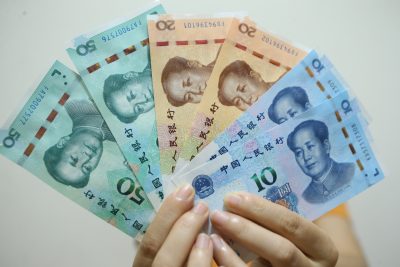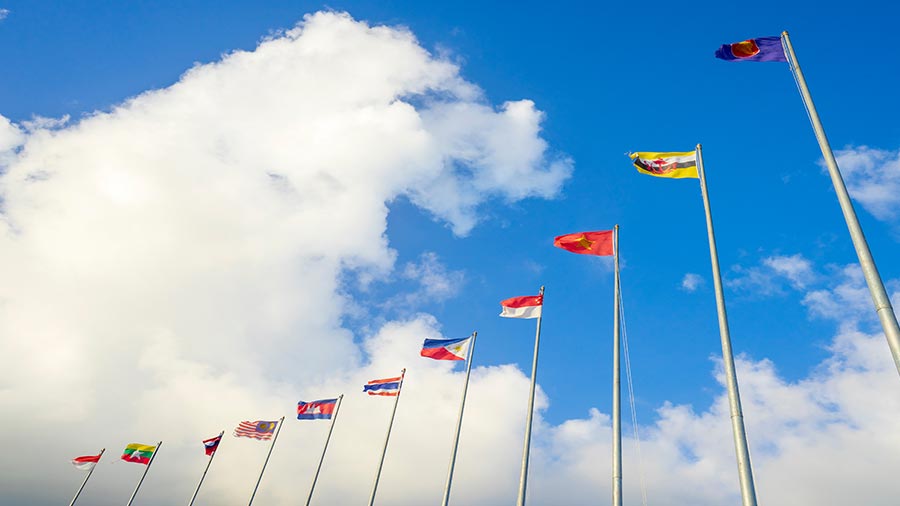China
The gradual internationalisation of the RMB

Author: Kathleen Walsh, UTS
China is an economic giant. It is the world’s largest trading nation and is set to be the world’s largest economy as early as next year. Yet China’s financial relations with the rest of the world and the offshore use of the Chinese renminbi (RMB) is limited. While the RMB ranked 5th as an international payments currency in June 2019, its share of global transactions was less than 2 per cent. In contrast, the share of transactions in USD was 40 per cent and the Euro held 34 per cent.
In some respects, it is not surprising that the RMB has such low usage offshore. While China’s current account has been freely traded since 2009, the capital account remains largely closed with flows in and out of China heavily restricted. China has signalled an appetite to liberalise its capital account but the pace and sequencing of reforms remain uncertain.
The key feature of an internationalised currency is that it is widely used by both the private and official sectors outside the currency’s home country. This usually requires the currency to be used as a unit of account for trade invoicing, a medium of exchange for trade settlement and broader financial transactions, and a reliable store of value such as foreign exchange reserves.
Because China has widespread capital controls but an open trade account, it relies heavily on encouraging greater RMB trade invoicing. Substantial increases in the use of RMB for trade settlement will necessitate use for investment and the demand for RMB reserves will follow, albeit slowly.
The establishment of an RMB hub to facilitate RMB transactions requires the appointment of an official settlement bank for offshore RMB transactions, an RMB Qualified Foreign Institutional Investor quota for reinvestment back into China and a swap facility to support the settlement of RMB. The network of offshore hubs provides a framework to facilitate offshore transactions, complementing onshore market reforms and international milestones such as inclusion of the RMB in the International Monetary Fund’s (IMF) international reserve basket, the special drawing rights.
China has publicly acknowledged its plans to internationalise the RMB and significantly increase the offshore use of RMB, but the commitment to reform has slowed considerably over the last few years. If China wanted to push the process it would only need to insist that state-owned enterprises settle their trade in RMB.
China is grappling with a rapidly transforming economy and the internationalisation of the RMB is but one of its many political and economic objectives. China appears to be content to slow the timeline for internationalisation and allow the process to evolve gradually.
Without further policy intervention, there needs to be a clear upside for corporates to incur the cost of using RMB for trade and investment. The advantages may not be clear for countries such as Australia where most of the trade with China is one directional. Australia either sells to or buys from China so the drive to settle in RMB and have it sitting on the balance sheet is very low. Globally, products like iron ore are priced in USD. Considerable structural change is needed for a shift in the trade currency used.
China is not relying solely on the use of RMB in trade to push its internationalisation agenda. In recent years it has implemented programs to attract more inflows while still maintaining strong controls on outflows. A major innovation was the introduction of the bond and stock connect programs allowing international investors access — through Hong Kong — into Shanghai and Shenzhen. The bulk of the flows are northbound into China, reflecting China’s competing priority to restrict outbound flows.
The 2019 launch of the Shanghai London Stock Connect provides a different model where investors trade in depository receipts rather than direct ownership due in part to the significant time gap between the two exchanges.
These programs are a necessary component of the decisions by global index managers like the MSCI and FTSE and bond index managers like JP Morgan to increase China’s weight in their benchmarks. The IMF estimates that benchmark driven portfolio inflows could reach US$450 billion over the next three years. On the surface this seems like a major step in the internationalisation of the RMB and the reform of China’s volatile equity market, but there are significant concerns around investor protection and uncertain regulations. These issues will not be resolved quickly.
It appears that the only strategies…
Business
Gordonstoun Severs Connections with Business Led by Individual Accused of Espionage for China

Gordonstoun school severed ties with Hampton Group over espionage allegations against chairman Yang Tengbo. He denies involvement and claims to be a victim of political tensions between the UK and China.
Allegations Lead to School’s Decision
Gordonstoun School in Moray has cut ties with Hampton Group International after serious allegations surfaced regarding its chairman, Yang Tengbo, who is accused of being a spy for the Chinese government. Known by the alias "H6," Mr. Tengbo was involved in a deal that aimed to establish five new schools in China affiliated with Gordonstoun. However, the recent allegations compelled the school to terminate their agreement.
Public Denial and Legal Action
In response to the spying claims, Mr. Tengbo publicly revealed his identity, asserting that he has committed no wrongdoing. A close associate of Prince Andrew and a former Gordonstoun student himself, Mr. Tengbo has strenuously denied the accusations, stating that he is a target of the escalating tensions between the UK and China. He has claimed that his mistreatment is politically motivated.
Immigration Challenges and Legal Responses
Yang Tengbo, also known as Chris Yang, has faced additional challenges regarding his immigration status in the UK. After losing an appeal against a ban enacted last year, he reiterated his innocence, condemning media speculation while emphasizing his commitment to clear his name. Gordonstoun, on its part, stated its inability to divulge further details due to legal constraints.
Source : Gordonstoun cuts ties with business chaired by man accused of spying for China
Business
China Dismantles Prominent Uyghur Business Landmark in Xinjiang – Shia Waves

The Chinese government demolished the Rebiya Kadeer Trade Center in Xinjiang, affecting Uyghur culture and commerce, prompting criticism from activists amid concerns over cultural erasure and human rights violations.
Demolition of a Cultural Landmark
The Chinese government recently demolished the Rebiya Kadeer Trade Center in Urumqi, Xinjiang, a vital hub for Uyghur culture and commerce, as reported by VOA. This center, once inhabited by more than 800 predominantly Uyghur-owned businesses, has been deserted since 2009. Authorities forcibly ordered local business owners to vacate the premises before proceeding with the demolition, which took place without any public notice.
Condemnation from Activists
Uyghur rights activists have condemned this demolition, perceiving it as part of China’s broader strategy to undermine Uyghur identity and heritage. The event has sparked heightened international concern regarding China’s policies in Xinjiang, which have been characterized by allegations of mass detentions and cultural suppression, prompting claims of crimes against humanity.
Rebiya Kadeer’s Response
Rebiya Kadeer, the center’s namesake and a notable Uyghur rights advocate, criticized the demolition as a deliberate attempt to erase her legacy. Kadeer, who has been living in exile in the U.S. since her release from imprisonment in 2005, continues to advocate for Uyghur rights. She has expressed that her family members have suffered persecution due to her activism, while the Chinese government has yet to comment on the legal ramifications of the demolition.
Source : China Demolishes Uyghur Business Landmark in Xinjiang – Shia Waves
China
China Expands Nationwide Private Pension Scheme After Two-Year Pilot Program

China’s private pension scheme, previously piloted in 36 cities, will roll out nationwide on December 15, 2024, enabling workers to open tax-deferred accounts. The initiative aims to enhance retirement savings, address aging population challenges, and stimulate financial sector growth.
After a two-year pilot program, China has officially expanded its private pension scheme nationwide. Starting December 15, 2024, workers covered by urban employee basic pension insurance or urban-rural resident basic pension insurance across the country can participate in this supplementary pension scheme. This nationwide rollout represents a significant milestone in China’s efforts to build a comprehensive pension system, addressing the challenges of a rapidly aging population.
On December 12, 2024, the Ministry of Human Resources and Social Security, together with four other departments including the Ministry of Finance, the State Taxation Administration, the Financial Regulatory Administration, and the China Securities Regulatory Commission, announced the nationwide implementation of China’s private pension scheme effective December 15, 2024. The initiative extends eligibility to all workers enrolled in urban employee basic pension insurance or urban-rural resident basic pension insurance.
A notable development is the expansion of tax incentives for private pensions, previously limited to pilot cities, to a national scale. Participants can now enjoy these benefits across China, with government agencies collaborating to ensure seamless implementation and to encourage broad participation through these enhanced incentives.
China first introduced its private pension scheme in November 2022 as a pilot program covering 36 cities and regions, including major hubs like Beijing, Shanghai, Guangzhou, Xi’an, and Chengdu. Under the program, individuals were allowed to open tax-deferred private pension accounts, contributing up to RMB 12,000 (approximately $1,654) annually to invest in a range of retirement products such as bank deposits, mutual funds, commercial pension insurance, and wealth management products.
Read more about China’s private pension pilot program launched two years ago: China Officially Launches New Private Pension Scheme – Who Can Take Part?
The nationwide implementation underscores the Chinese government’s commitment to addressing demographic challenges and promoting economic resilience. By providing tax advantages and expanding access, the scheme aims to incentivize long-term savings and foster greater participation in personal retirement planning.
The reform is expected to catalyze growth in China’s financial and insurance sectors while offering individuals a reliable mechanism to enhance their retirement security.
| This article was first published by China Briefing , which is produced by Dezan Shira & Associates. The firm assists foreign investors throughout Asia from offices across the world, including in in China, Hong Kong, Vietnam, Singapore, and India . Readers may write to info@dezshira.com for more support. |
Read the rest of the original article.






